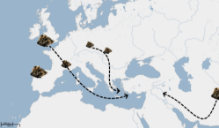The Haifa ingots are made of tin, a soft, silvery metal. We use tin today to solder and to coat iron. In the Bronze Age, tin was mainly used to produce bronze. By alloying copper with a little bit of tin, the bronze alloy hardens. Adding tin to copper also makes the alloy melt more easily and thus makes it easier to cast into various shapes and sizes. These two characteristics make bronze very useful for manufacturing advanced weapons and tools (Fig. 5). Tin, therefore, was of great importance to Bronze Age societies.It has even been speculated that a shortage of tin ultimately led to bronze falling out of fashion at the end of the Bronze Age and subsequently to an increase in the use of iron. See Evely 2010. [‘Materials and Industries’](DOI: 10.1093/oxfordhb/9780199873609.001.0001), p. 389.
So, where does the tin of the Haifa ingots come from? Probably all the way from Cornwall in the UK. This means that the tin travelled more than 3500 km, from Britain to Israel!The mining locations of tin in prehistoric times have puzzled scholars for a long time. A few tin deposits around the Near East are known to us, but they do not seem to have been exploited in the Bronze Age (Berger et al. 2019. ‘Isotope systematics and chemical composition of tin ingots from Mochlos (Crete) and other Late Bronze Age sites in the eastern Mediterranean Sea: An ultimate key to tin provenance?’, p.7. At first, scholars believed that the majority of tin was mined in the Caucasus. Later this was reconsidered and, on the basis of mainly textual evidence, Afghanistan was thought to hold the main mines for tin for bronze work in the Bronze Age (Ibid, p. 8). However, because of a lack of archaeological evidence, scholars failed to confirm this theory. Recently, a novel method of analyzing metals has shed new light on the problem of tin in the Bronze Age. By studying the isotope composition of the tin, scholars are able to point out where the metal was originally mined. On the basis of this type of analysis, scholars have pointed out Cornwall in the UK as the most likely candidate for the place of provenance for the tin of the Haifa ingots (Ibid p. 36-7). This has, of course, significant implications for our views of trade and economy of the Bronze Age. However, the fact that the tin probably originated in England, does by no means mean that the metal was also processed there. As to where the ores were smelted and the tin was cast, the inscriptions on the ingots might give a hint. But before we go to the inscriptions, let us have a look at another detail: the deformities.
Do you want to know more about trade in the Bronze Age? In the long read we tell you more about Bronze Age trade networks by land and sea.

](https://micrio.thingsthattalk.net/JbNDy/views/max/128x128.jpg)
](https://micrio.thingsthattalk.net/CVQLt/views/max/128x128.jpg)
](https://micrio.thingsthattalk.net/hhyar/views/max/128x128.jpg)